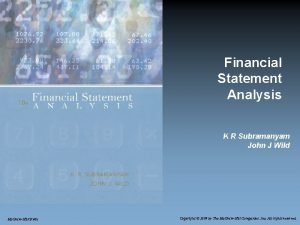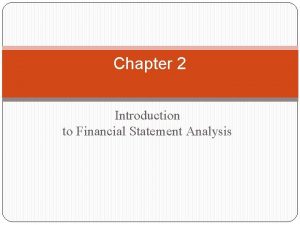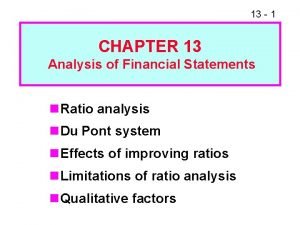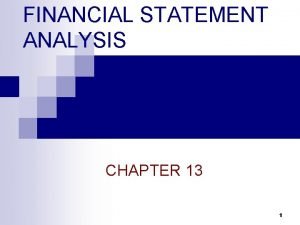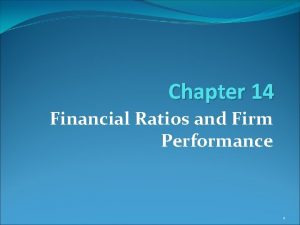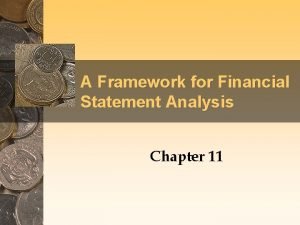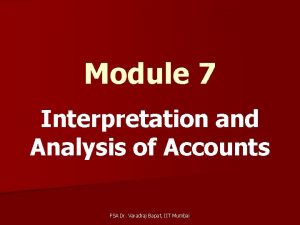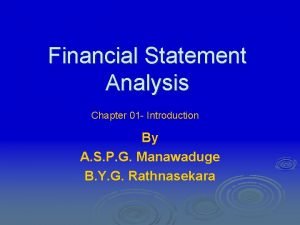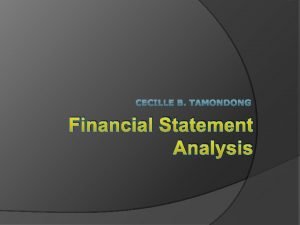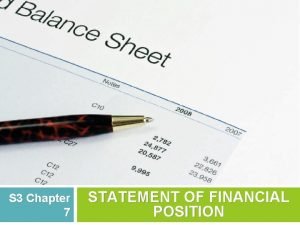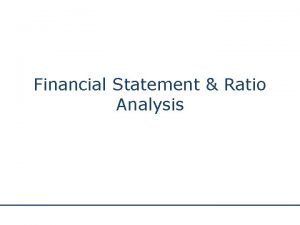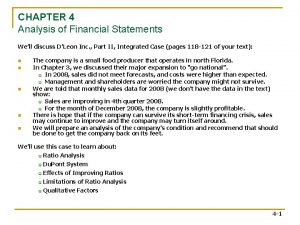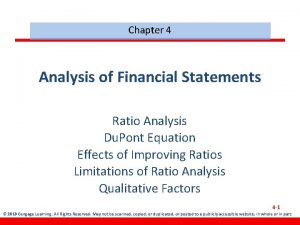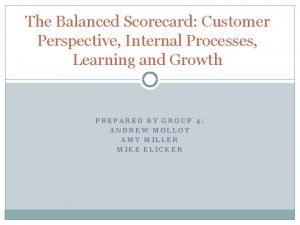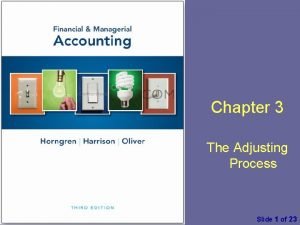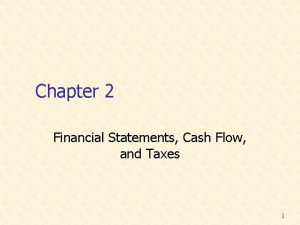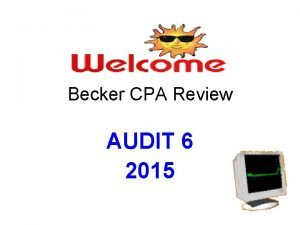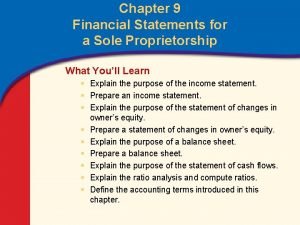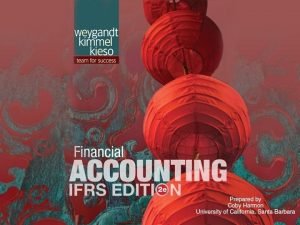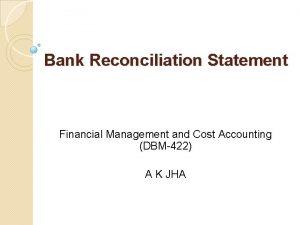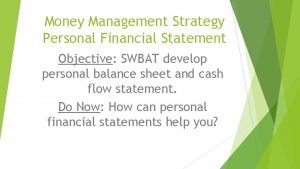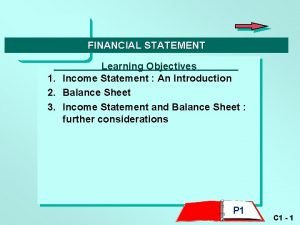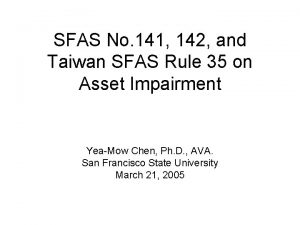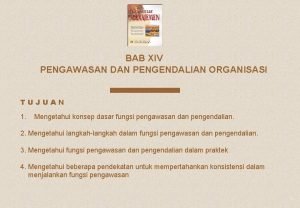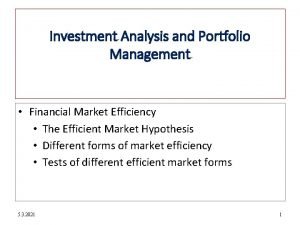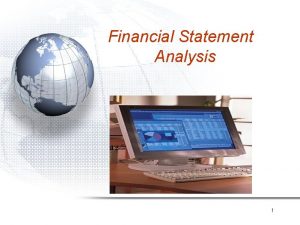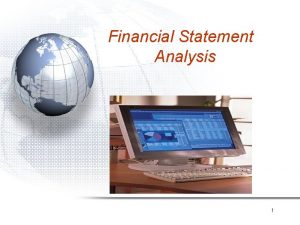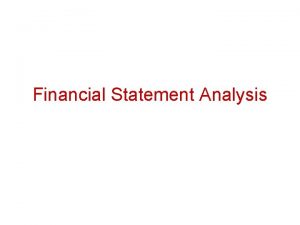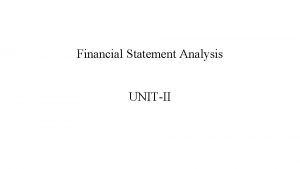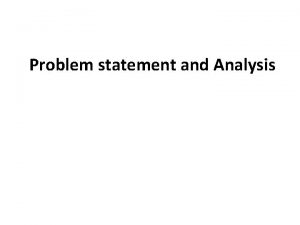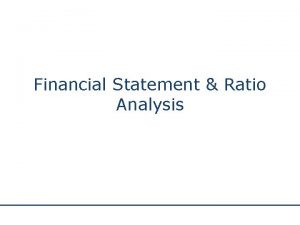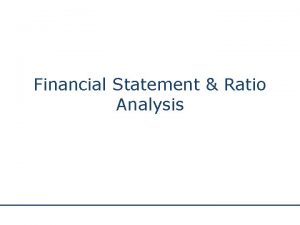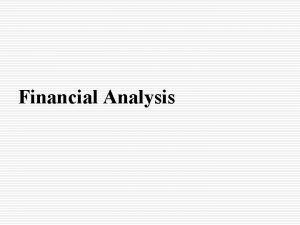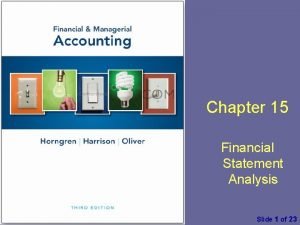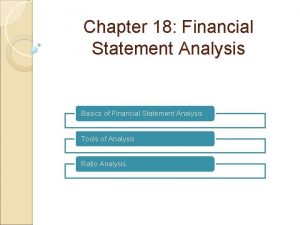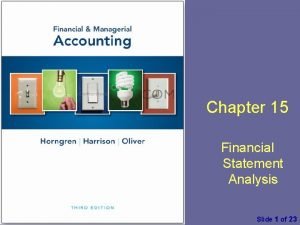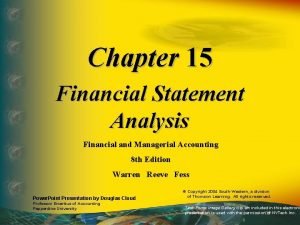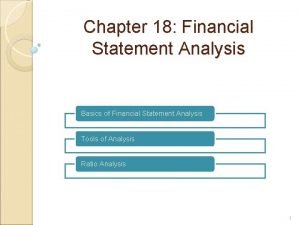Chapter 15 Financial Statement Analysis Chapter 15 Learning

























































- Slides: 57

Chapter 15 Financial Statement Analysis

Chapter 15 Learning Objectives 1. Explain how financial statements are used to analyze a business 2. Perform a horizontal analysis of financial statements © 2018 Pearson Education, Inc. 15 -2

Chapter 15 Learning Objectives 3. Perform a vertical analysis of financial statements 4. Compute and evaluate the standard financial ratios © 2018 Pearson Education, Inc. 15 -3

Learning Objective 1 Explain how financial statements are used to analyze a business © 2018 Pearson Education, Inc. 15 -4

HOW ARE FINANCIAL STATEMENTS USED TO ANALYZE A BUSINESS? • To determine the financial performance of a company, we compare its performance in the following ways: – From year to year – With a competing company – With the same industry as a whole © 2018 Pearson Education, Inc. 15 -5

Tools of Analysis • There are three main ways to analyze financial statements: – Horizontal analysis provides a year-to-year comparison of a company’s performance in different periods. – Vertical analysis provides a way to compare different companies. – Ratio analysis can be used to provide information about a company’s performance. © 2018 Pearson Education, Inc. 15 -6

Corporate Financial Reports • An annual report provides information about a company’s financial condition. – Management’s discussion and analysis of financial conditions and results of operations (MD&A) – Report of the independent auditors – Financial statements – Notes to financial statements © 2018 Pearson Education, Inc. 15 -7

Learning Objective 2 Perform a horizontal analysis of financial statements © 2018 Pearson Education, Inc. 15 -8

HOW DO WE USE HORIZONTAL ANALYSIS TO ANALYZE A BUSINESS? • Many decisions hinge on whether the numbers are increasing or decreasing. • Sales may have increased, but considered in isolation, this fact is not very helpful. • Horizontal analysis is the study of percentage changes in line items from comparative financial statements. © 2018 Pearson Education, Inc. 15 -9

HOW DO WE USE HORIZONTAL ANALYSIS TO ANALYZE A BUSINESS? Smart Touch Learning has net sales of $858, 000 in 2020 and $803, 000 in 2019. Prepare the horizontal analysis: • Step 1: Compute the dollar amount of change in sales from 2019 to 2020 • Step 2: Divide the dollar amount of change by the base period amount and multiply by 100. This computes the percentage change for the period: © 2018 Pearson Education, Inc. 15 -10

© 2018 Pearson Education, Inc. 15 -11

Horizontal Analysis of the Balance Sheet © 2018 Pearson Education, Inc. 15 -12

Trend Analysis • Trend analysis is a form of horizontal analysis. • Trend percentages indicate the direction a business is taking. • The formula for trend analysis is as follows: © 2018 Pearson Education, Inc. 15 -13

Trend Analysis Smart Touch Learning’s Net Sales Revenue was $750, 000 in 2016 and rose to $858, 000 in 2020. The trend percentage for 2017 is calculated as follows: © 2018 Pearson Education, Inc. 15 -14

Learning Objective 3 Perform a vertical analysis of financial statements © 2018 Pearson Education, Inc. 15 -15

HOW DO WE USE VERTICAL ANALYSIS TO ANALYZE A BUSINESS? • Vertical analysis of a financial statement shows the relationship of each item to its base amount, the 100% figure. • Every other item on the statement is then reported as a percentage of that base. © 2018 Pearson Education, Inc. 15 -16

© 2018 Pearson Education, Inc. 15 -17

Vertical Analysis of the Balance Sheet © 2018 Pearson Education, Inc. 15 -18

Common-Size Statements • To compare one company to another company, we can use a common-size statement. • A common-size statement reports only percentages. • By reporting only percentages, it removes the dollar value bias we see when comparing numbers in absolute terms (dollars). © 2018 Pearson Education, Inc. 15 -19

© 2018 Pearson Education, Inc. 15 -20

Benchmarking • Benchmarking is the practice of comparing a company with other leading companies. • There are two main types of benchmarking: – Benchmarking against a key competitor – Benchmarking against the industry average © 2018 Pearson Education, Inc. 15 -21

Benchmarking © 2018 Pearson Education, Inc. 15 -22

Learning Objective 4 Compute and evaluate the standard financial ratios © 2018 Pearson Education, Inc. 15 -23

HOW DO WE USE RATIOS TO ANALYZE A BUSINESS? • Different ratios explain different aspects of a company. • Ratios are used for the following purposes: – Evaluating the ability to pay current liabilities and long-term debt – Evaluating the ability to sell merchandise inventory and collect receivables – Evaluating profitability – Evaluating stock as an investment © 2018 Pearson Education, Inc. 15 -24

HOW DO WE USE RATIOS TO ANALYZE A BUSINESS? © 2018 Pearson Education, Inc. 15 -25

HOW DO WE USE RATIOS TO ANALYZE A BUSINESS? © 2018 Pearson Education, Inc. 15 -26

Evaluating the Ability to Pay Current Liabilities • We discuss one equation and three ratios that measure a company’s ability to pay current liabilities: – – Working capital Cash ratio Acid-test (or quick) ratio Current ratio © 2018 Pearson Education, Inc. 15 -27

Working Capital • Working capital measures the ability to meet short-term obligations with current assets. Working capital is defined as follows: © 2018 Pearson Education, Inc. 15 -28

Cash Ratio • The cash ratio helps determine a company’s ability to meet its short-term obligations. © 2018 Pearson Education, Inc. 15 -29

Acid-Test (or Quick) Ratio • The acid-test ratio (sometimes called the quick ratio) tells whether a company can pay all its current liabilities if they come due immediately. © 2018 Pearson Education, Inc. 15 -30

Current Ratio • The most widely used ratio is the current ratio, which is calculated as the total current assets divided by total current liabilities. • The current ratio measures a company’s ability to pay its current liabilities with its current assets. © 2018 Pearson Education, Inc. 15 -31

Evaluating the Ability to Sell Merchandise Inventory and Collect Receivables • We look at five ratios that measure a company’s ability to sell merchandise inventory and collect receivables: – – – Inventory turnover Days’ sales in inventory Gross profit percentage Accounts receivable turnover ratio Days’ sales in receivables © 2018 Pearson Education, Inc. 15 -32

Inventory Turnover • The inventory turnover ratio measures the number of times a company sells its average level of merchandise inventory during a year. © 2018 Pearson Education, Inc. 15 -33

Days’ Sales in Inventory • Days’ sales in inventory measures the average number of days merchandise inventory is held by the company. © 2018 Pearson Education, Inc. 15 -34

Gross Profit Percentage • The gross profit percentage measures the profitability of each net sales dollar above the cost of goods sold. © 2018 Pearson Education, Inc. 15 -35

Accounts Receivable Turnover Ratio • The accounts receivable turnover ratio measures the number of times the company collects the average receivables balance in a year. © 2018 Pearson Education, Inc. 15 -36

Days’ Sales in Receivables • Days’ sales in receivables indicates how many days it takes to collect the average level of receivables. © 2018 Pearson Education, Inc. 15 -37

Evaluating the Ability to Pay Long-term Debt • Most businesses have long-term debt. • There are three key indicators of a business’s ability to pay long-term liabilities: – Debt ratio – Debt to equity ratio – Times-interest-earned ratio © 2018 Pearson Education, Inc. 15 -38

Debt Ratio • The debt ratio shows the proportion of assets financed with debt and is calculated by dividing total liabilities by total assets. © 2018 Pearson Education, Inc. 15 -39

Debt to Equity Ratio • The debt to equity ratio shows the proportion of total liabilities relative to total equity. • This ratio measures financial leverage. © 2018 Pearson Education, Inc. 15 -40

Times-Interest-Earned Ratio • The times-interest-earned ratio evaluates a business’s ability to pay interest expense. This ratio is also called the interestcoverage ratio. © 2018 Pearson Education, Inc. 15 -41

Evaluating Profitability • We now look at five ratios that are used to evaluate a company’s profitability: – – – Profit margin ratio Rate of return on total assets Asset turnover ratio Rate of return on common stockholders’ equity Earnings per share © 2018 Pearson Education, Inc. 15 -42

Profit Margin Ratio • The profit margin ratio shows how much net income a business earns on every $1 of sales. © 2018 Pearson Education, Inc. 15 -43

Rate of Return on Total Assets • The rate of return on total assets measures a company’s success in using assets to earn a profit. © 2018 Pearson Education, Inc. 15 -44

Asset Turnover Ratio • The asset turnover ratio measures the amount of net sales generated for each average dollar of total assets invested. © 2018 Pearson Education, Inc. 15 -45

Rate of Return on Common Stockholders’ Equity • The rate of return on common stockholders’ equity shows how much income is earned for each $1 invested by the common shareholders. © 2018 Pearson Education, Inc. 15 -46

Rate of Return on Common Stockholders’ Equity • When a company has a higher rate of return on stockholders’ equity than its rate of return on total assets, this is called trading on the equity. • Trading on the equity is earning more income on borrowed money than the related interest expense, thereby increasing the earnings for the owners of the business. © 2018 Pearson Education, Inc. 15 -47

Earnings per Share (EPS) • Earnings per share (EPS) reports the amount of net income (loss) for each share of the company’s outstanding common stock. © 2018 Pearson Education, Inc. 15 -48

Evaluating Stock as an Investment • Investors purchase stock to earn a return on their investment. • This return consists of two parts: – Gains (or losses) from selling the stock at a price above (or below) purchase price – Dividends © 2018 Pearson Education, Inc. 15 -49

Price/Earnings Ratio • The price/earnings ratio is the ratio of the market price of a share of common stock to the company’s earnings per share. © 2018 Pearson Education, Inc. 15 -50

Dividend Yield • The dividend yield measures the percentage of a stock’s market value that is returned annually as dividends to shareholders. © 2018 Pearson Education, Inc. 15 -51

Dividend Payout • The dividend payout measures the percentage of earnings paid annually to common shareholders as cash dividends. © 2018 Pearson Education, Inc. 15 -52

Red Flags in Financial Statement Analyses • Analysts look for red flags in financial statements that may signal financial trouble. Examples: – Movement of sales, merchandise inventory, and receivables – Earnings problems – Decreased cash flow – Too much debt – Inability to collect receivables – Buildup of merchandise inventories © 2018 Pearson Education, Inc. 15 -53

HOW DO WE USE RATIOS TO ANALYZE A BUSINESS? © 2018 Pearson Education, Inc. 15 -54

© 2018 Pearson Education, Inc. 15 -55

© 2018 Pearson Education, Inc. 15 -56

© 2018 Pearson Education, Inc. 15 -57
 Chapter 14 financial statement analysis solutions
Chapter 14 financial statement analysis solutions Kr subramanyam
Kr subramanyam Chapter 14 financial statement analysis solutions
Chapter 14 financial statement analysis solutions Chapter 2 financial statement analysis solutions
Chapter 2 financial statement analysis solutions Chapter 13 financial statement analysis
Chapter 13 financial statement analysis Analysis of financial statements
Analysis of financial statements Chapter 1 overview of financial statement analysis
Chapter 1 overview of financial statement analysis Chapter 14 financial statement analysis
Chapter 14 financial statement analysis Cuadro comparativo e-learning y b-learning
Cuadro comparativo e-learning y b-learning Financial analysis framework
Financial analysis framework Financial statement analysis objectives
Financial statement analysis objectives Module 7 financial statement analysis
Module 7 financial statement analysis Introduction of financial statement analysis
Introduction of financial statement analysis Financial analysis of banks
Financial analysis of banks What is vertical financial statement analysis
What is vertical financial statement analysis Limitations of financial statement analysis
Limitations of financial statement analysis Financial analysis assessment
Financial analysis assessment Financial statement analysis and planning
Financial statement analysis and planning Financial motivators
Financial motivators Chapter 03 financial analysis
Chapter 03 financial analysis Chapter 4 analysis of financial statements
Chapter 4 analysis of financial statements Chapter 4 analysis of financial statements
Chapter 4 analysis of financial statements How to improve current ratio
How to improve current ratio Internal process perspective examples
Internal process perspective examples Tori’s statement of financial position
Tori’s statement of financial position Financial position statement
Financial position statement The purpose of financial statement
The purpose of financial statement Financial statement robert kiyosaki
Financial statement robert kiyosaki Parents financial statement
Parents financial statement Nature of financial statement
Nature of financial statement Income statement in financial accounting
Income statement in financial accounting Financial statement in millions
Financial statement in millions Becker & smith cpas performs
Becker & smith cpas performs In-house financial statement
In-house financial statement Report form statement of financial position
Report form statement of financial position Operating income formula
Operating income formula Statement of financial position
Statement of financial position No financial disclosure statement
No financial disclosure statement Chapter 9 financial statements for a sole proprietorship
Chapter 9 financial statements for a sole proprietorship Merchandising income statement
Merchandising income statement Parents' financial statement sample
Parents' financial statement sample Classified statement of financial position
Classified statement of financial position Financial statement comparability
Financial statement comparability Translate financial statements
Translate financial statements Cost accounting reconciliation statement
Cost accounting reconciliation statement Structure of financial statement
Structure of financial statement Financial position account form
Financial position account form Balance sheet red flags
Balance sheet red flags Personal statement of financial position
Personal statement of financial position Parents financial statement
Parents financial statement Parents' financial statement sample
Parents' financial statement sample Carriage inwards in financial statement
Carriage inwards in financial statement Statement of financial accounting standards no 141
Statement of financial accounting standards no 141 Pengawasan dan pengendalian organisasi
Pengawasan dan pengendalian organisasi Financial investment analysis
Financial investment analysis Financial analysis for product management
Financial analysis for product management Financial investment analysis
Financial investment analysis Under armour financial analysis
Under armour financial analysis

